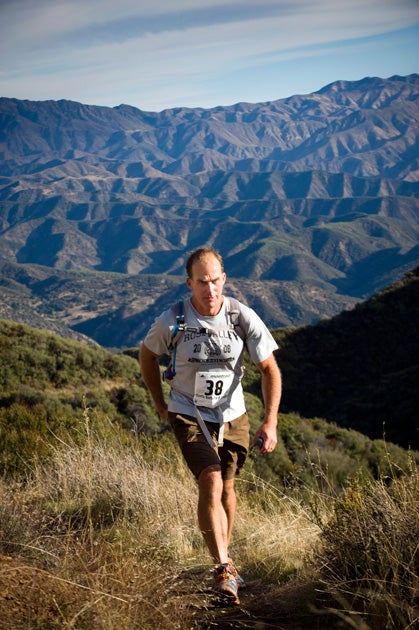Walk, Don't Run

How hiking can speed up your trail runs
Do you think walking is anathema to trail running? You’re plain wrong. It’s all a matter of degrees. Even the world’s best trail runners walk when the terrain, slope and distance dictate they do so. And, we’re not just talking about ultramarathons. For instance, during the 12-kilometer 2010 World Mountain Running Championships, Max King, the second American on the United States’ silver-medal-winning team, “didn’t walk much, but there was a steep two-mile section of which I walked probably 10 percent. I never like to [walk], but sometimes it just makes sense.”
Photo by Kevin Steele
This article appeared in our March 2011 issue.
Why Walk?
As humans, we have two primary forms of bipedal locomotion: running and walking. As a general rule, walking is more energy efficient at slower speeds while running is more efficient at faster speeds. This principle does not change when we begin charging up a hill. The constant tug of gravity’s pull does, however, reduce the speed at which the transition from running to walking occurs, for two reasons.
First, there’s the physics. Running is essentially a series of bounds separated by a moment of suspension. During the suspension phase, gravity accelerates us downward, which results in a “tall” parabolic arc with an increased vertical component. We use significant energy to launch ourselves into the suspension phase against the pull of gravity.
On the other hand, walking lacks the moment of suspension. Instead, we travel in a series of “flatter” circular arcs. When we run up a hill, we need to exaggerate the height of flight phase, while there is no flight phase to exaggerate when walking uphill. Ultrarunner Krissy Moehl succinctly crystallized this concept, “Walking takes the bouncing out of your stride.”
Second, as a hill’s gradient increases, so will the effort required to run up it. In longer races, the effort needed to run a particular incline may exceed the average effort a runner will optimally expend during the race and, therefore, burn through fuel stores too fast. In shorter races, it might simply be impossible to continue running up a steep pitch.
When to Walk
First, you must decide that you are willing to walk, which may be difficult for runners who have primarily run shorter distances or come from road-running backgrounds. If in doubt, try it in training or a low-key race environment. Know that you’re not swallowing your pride when you walk; you’re simply taking part in an activity that includes both running and walking.
To determine when to start walking, look for two clues. If your breathing is ragged on any hill, that’s an excellent sign you should be walking. In addition, unless you’re nearing the finish line, if you’re running up a hill and everyone around you is walking, take the hint. Tonya Olson, a physical therapist, learned that lesson early in her ultrarunning career, “If everyone experienced in a sport is engaging in an activity, then maybe you should, too.”
When does Max King switch to walking? “It’s usually when I’m redlining and I just need a quick break to bring my heart rate back down a few beats. Also, if I figure out that walking is just as fast as running, then it’s pointless not to walk.”
As you gain experience, you will build awareness of how to maintain an even effort on the ups, flats and downs. You’ll know when to downshift from running to walking on a hill. Obviously, this perceived target effort tends to be harder in racing than in training and harder in shorter runs than in longer ones.
How to Walk
The most common mistake is walking and using the wrong muscles. Says Olson, “You should push yourself up the mountain with your glutes, rather than pull yourself with your quads and calves.” Not only will you be using a bigger set of muscles when you need them most, you’ll be resting other muscles for running the trail.
To help engage your glutes (aka butt muscles), lean slightly forward with your center of mass slightly in front of your pelvis. However, don’t hunch over, and keep your back straight.
Once you are employing your glutes, focus on shortening your stride (when you look down, your line of sight should fall even with your toes) and maintaining an even cadence. Long strides with a large moment of suspension are a big energy waster.
Consider using trekking poles while walking up extremely steep or long climbs, particularly in marathon or longer events. (See Trail Tips, June 2010, Issue 66 for more on trekking poles.) They can help you power up a hill. In contrast, avoid using your hands on your knees while you’re climbing, as that’s a sign you’re engaging your quads rather than your glutes.
The single best way to improve your uphill walking? Practice. Otherwise, Olson advises trying any activity or exercise that isolates the glutes, such as side-lying hip abduction, a single-leg bridge or a split squat with your rear foot elevated (see www.tensegrityphysicaltherapy.com/exercises.html).